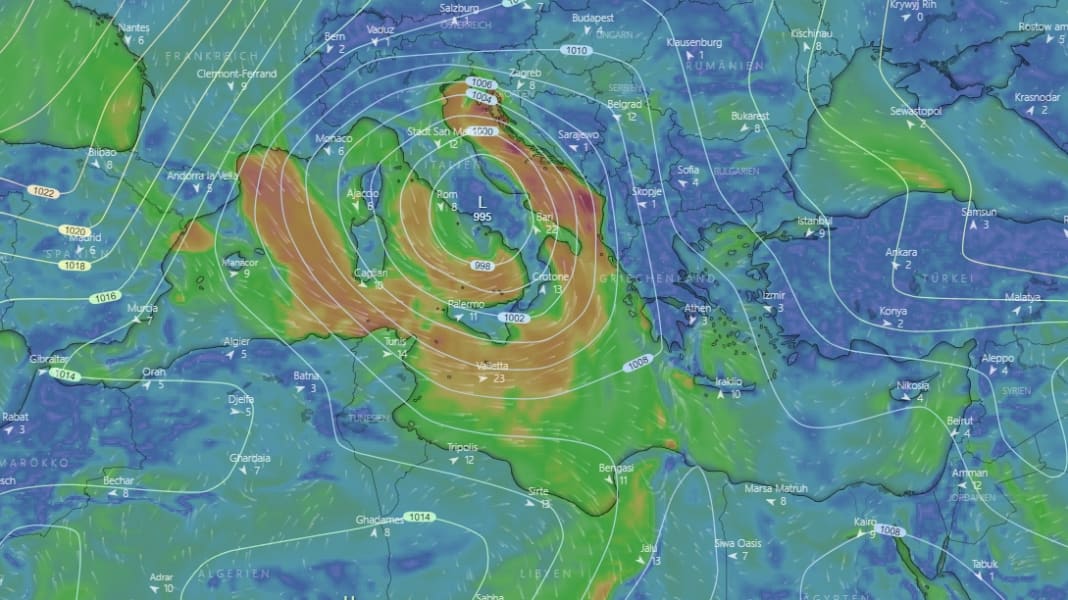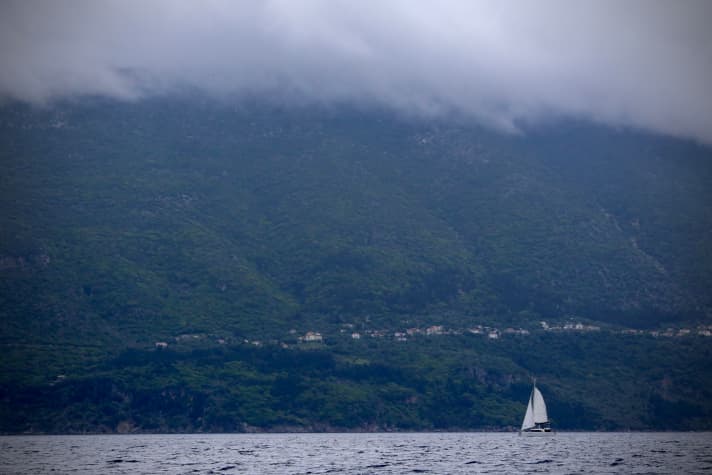
Torrential, very prolonged rainfall has been causing flooding in Italy and Croatia for days, in some cases with fatalities and injuries. The cause of this is a low-pressure vortex lying as if nailed down over Italy, which was initially located over the heel of the boot, is now in the centre and is barely moving eastwards. Instead, it appears to be filling up and then deepening again. It has been determining the weather in the region for almost 14 days now. Colleagues from the YACHT editorial team were also caught up in this unusual weather scenario during a cruise in the Ionian Sea: starting from Corfu, they wanted to sail down to the Peloponnese and on to Athens. But persistent, strong southerly winds, sometimes with gusts of 50 knots and constant rain, blocked the route to Cape Maleas on the Peloponnese. For days, the clouds hung so low on the ridge of the island that it was reminiscent of a trip to the Hebrides. In between, there were two days of sunshine and calm, and then it started again. Crews on the Croatian coast are currently experiencing a similar situation.

Of course, May is not an entirely reliable month in the western Mediterranean, but such long periods of bad weather are rather rare during this time. In my search for explanations, I stumbled across a first reference in a new edition of the Greece cruising guide by the Brit Rod Heikell, a legend in the business. The Brit has been sailing in Greece for 45 years, mostly starting from Lefkas. Regarding the weather in the area, he notes that, according to his observations and those of some locals, the weather is changing. The early season is becoming increasingly unstable, while the late season is more extreme with weather extremes such as Medicanes.
A consequence of climate change?
I've been travelling in the area for 25 years and have a similar experience. In the last five years, I've twice been caught up in Medicanes in the Aegean, the strength and duration of which were terrifying. The first time I experienced this was when the authorities closed all Aegean harbours. The harbour masters went around and informed us skippers that leaving the harbour was categorically forbidden. I had never experienced that in 25 years of sailing in Greece. Later, the wind and rainfall were indeed of almost biblical proportions. And now this spring low lying over Italy as if nailed down, tirelessly shovelling in humid, stormy air masses.
In search of further explanations, I call YACHT weather expert Dr Michael Sachweh. He has packed his bags for the tornado season in the USA and only has a short time for a chat.
"We have been observing these very slow or practically non-existent lows for some time. It seems to be a consequence of climate change. The jet stream at high altitude is very weak and the movement of the systems it pulls along has become slower as a result," he explains. Whereas in the past such systems usually moved through in two to three days, they now sometimes remain almost in one place for a week, filling up or deepening again.
Storms in Italy and Croatia: a blessing and a curse
For the sailors, the bad weather with lots of clouds and rain also means a long-lasting, stable wind situation, with a bit of bad luck exactly from the direction in which it should go - in our case south. For people on land, the masses of water in the baggage of the lows mean completely different risks: Especially in mountainous regions, the water often triggers flooding and landslides. Up to 250 litres of rain per square metre in 24 hours have been reported in Italy and Croatia.
But there is also good news: the rainfall is actually a blessing for nature. The region in the north of Italy in particular suffered from an extreme drought and now lakes and rivers, for example in the Po Valley, are filling up again. The threat of drought with massive crop failures, which was feared for this year, seems to have been averted. And so, as sailors, we sit on board our yacht with mixed feelings, which, due to the lack of heating, begins to "damp" unpleasantly after three days in the rain, as the Süddeutsche says, describing clammy clothes. There's only one thing to do: to boot up to the nearest nice tavern in our oilskins and simply ignore the bad weather. "Siga, siga", as the Greeks say - take it easy.

